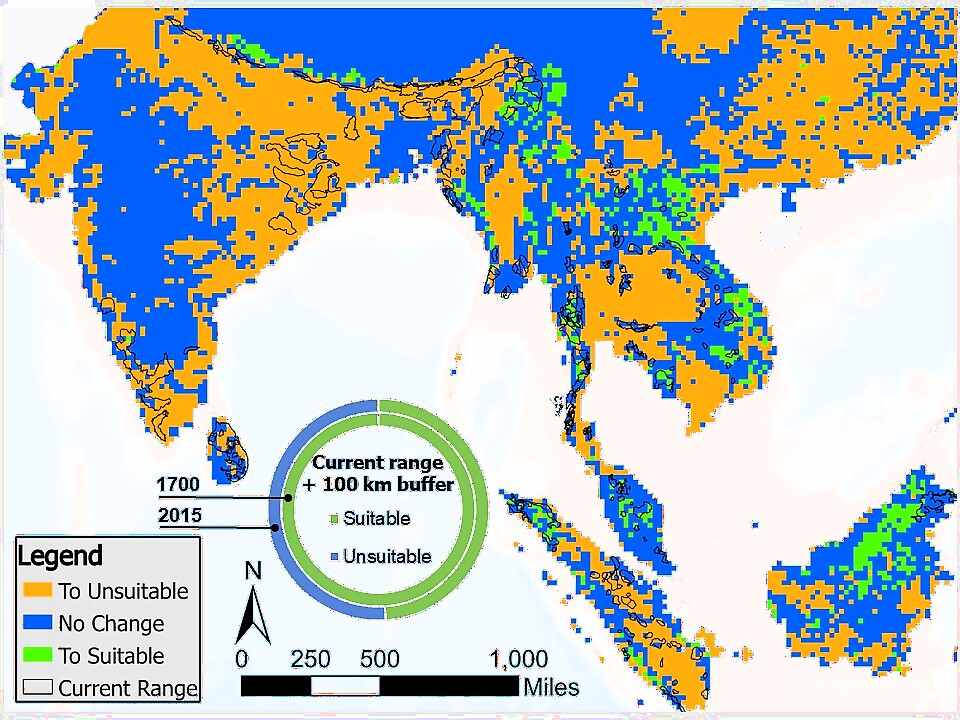
views
Home to 60% of the world’s remaining population of Asian Elephants, India lost more than half of its historic habitat range of elephants in the past three centuries, shows the latest estimate led by an international team of researchers. This drastic decline in suitable ecosystems – rainforests and grasslands – will lead to an increase in human-wildlife conflicts, a major challenge before the range countries, says the report.
The research team assessed the habitat range of Asian elephants in 13 countries across Asia from 1700 to 2015 and studied their land-use change data sets. The estimate published in peer-reviewed journal Scientific Reports shows a troubling scenario.
The region lost nearly 64% of the habitat which was once suitable for the elephants – a loss that equates to nearly 3.3 million square km of land since 1700. It found a long-term decline of grasslands and rainforest ecosystems that once spanned the breadth of the continent.
India was found to be among the six countries along with Mainland China, Bangladesh, Thailand, Vietnam and Sumatra, which lost more than half their suitable elephant habitat range. In fact, the greatest loss has occurred in China (around 94% of suitable habitat lost) and India (−86%).
While these areas remained relatively stable prior to the 1700s, colonial-era land-use practices and subsequent agricultural intensification cut the average habitat patch size by nearly 83%, from 99,000 to 16,000 sq km, the team noted.
The researchers noted that elephants’ historical range extended well beyond the current protected areas, which are now of insufficient size to support elephant populations in Asia. Now if the trends continue unabated, the remaining elephant populations today may not have adequate habitat areas. This is likely to set up a high potential for conflicts with humans living in those areas, they warn.

RISE IN HUMAN-WILDLIFE CONFLICTS
Threatened by loss of habitat, ecosystem degradation and poaching, only 60,000 Asian elephants now remain in the wild. As many as 29,964 of these elephants are in India, which is home to more than 60% of the wild Asian Elephants, as per the last census conducted in 2017. However, with competition for resources, countries like India are also witnessing rise in the human-elephant conflicts.
According to the government data, nearly 1,500 people died of elephant attacks in India in the past three years. The period also recorded as many as 266 elephant deaths – 41 in train accidents, 198 due to electrocution, 27 to poaching and eight to poisoning. On an average, 500 people are killed annually by elephants and about 100 elephants are killed in retaliation by people, says the government which is now also revisiting the elephant corridors of the country.
Meanwhile, other countries like Bhutan, Nepal and Sri Lanka lost more suitable habitat inside than outside the current elephant range, according to the estimate.
When the research team compared the area within 100 km of the current range of elephants in Asia, they found that in 1700, 100% of the area could have been considered suitable habitat but by 2015 less than half was considered suitable (48.6%).
“There is evidence of a dramatic change in land use, not just in Asia, but globally,” said lead author Shermin de Silva from the University of California San Diego and founder of the non-profit Trunks & Leaves, who led the study. “Around the world, we see a really dramatic transformation that has consequences that persist even to this day.”
The research highlighted an urgent need for sustainable land-use and conservation strategies, but also cautioned that habitat restoration must be guided under a reckoning of social and environmental justice for historically marginalised communities.
Read all the Latest India News here




















Comments
0 comment